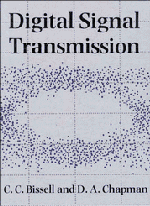Book contents
- Frontmatter
- Contents
- Preface
- 1 Introduction
- PART 1 MODELS
- 2 Signals and systems
- 3 Random signals and noise
- PART 2 PROCESSES
- PART 3 DIGITAL TRANSMISSION OVER THE PUBLIC SWITCHED TELEPHONE NETWORK
- Appendix A Fourier series and transforms
- Appendix B Convolution
- Appendix C Modelling applications of spreadsheets
- Answers to numerical exercises
- References
- Index
2 - Signals and systems
from PART 1 - MODELS
Published online by Cambridge University Press: 05 June 2012
- Frontmatter
- Contents
- Preface
- 1 Introduction
- PART 1 MODELS
- 2 Signals and systems
- 3 Random signals and noise
- PART 2 PROCESSES
- PART 3 DIGITAL TRANSMISSION OVER THE PUBLIC SWITCHED TELEPHONE NETWORK
- Appendix A Fourier series and transforms
- Appendix B Convolution
- Appendix C Modelling applications of spreadsheets
- Answers to numerical exercises
- References
- Index
Summary
Introduction
Fig. 2.1 introduces some of the most important phenomena which need to be modelled and analysed in digital signal transmission. It shows part of a system for transmitting binary data coded as two different voltage levels: a simple non-return-to-zero (NRZ) code has been assumed, in which a binary 1 is represented by a positive voltage for the duration of a complete symbol period, and binary 0 is represented by zero volts. The transmission medium might be a coaxial cable, as often used in small scale local networks. Similar principles apply, however, to systems using other transmission media and/or more complicated codes.
Fig. 2.1 also shows (not to scale) typical waveforms at various points in the system. After passing down the cable the original waveform A is attenuated (by an amount depending on the length of the cable) and, because of a finite system response time, the clear transitions between the two voltage levels have become indistinct. In practice there will also be a delay, corresponding to the time taken for the signal to pass along the cable, although this has not been shown explicitly. Neither are the effects of any noise included.
To counteract the distortion illustrated, the system includes an equaliser, which ‘sharpens’ the received waveform, so that the relationship of the equaliser output C to the original binary symbols is much clearer. Passing this equalised waveform through a threshold detector (a circuit whose output is one of two voltage levels depending on whether the input is greater or less than a pre-set threshold) has the result of generating a binary signal very similar to the transmitted one.
- Type
- Chapter
- Information
- Digital Signal Transmission , pp. 16 - 61Publisher: Cambridge University PressPrint publication year: 1992



